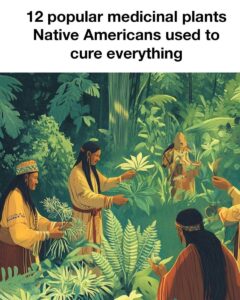
For centuries, Native American tribes have relied on the natural world for their medicinal needs, harnessing the healing properties of plants found in their environment. These plants were not only used to treat ailments but also played a significant role in cultural and spiritual practices. This knowledge, passed down through generations, highlights a profound understanding of the natural world and its potential to heal.
The Historical Significance of Native American Herbal Medicine
Native American herbal medicine is deeply rooted in tradition and spirituality. Each tribe had its own unique set of practices and beliefs surrounding the use of medicinal plants. These practices were often intertwined with spiritual rituals, emphasizing the holistic approach to health that considers the mind, body, and spirit. The historical significance of these practices is evident in their continued use and the growing interest in traditional medicine today.
Understanding the Healing Properties of Medicinal Plants
Medicinal plants contain a variety of compounds that can have therapeutic effects on the human body. These include alkaloids, flavonoids, tannins, and essential oils, among others. Native Americans had an intuitive understanding of these properties and used them to treat a wide range of conditions, from infections to pain relief. Modern science continues to explore these plants, validating many of their traditional uses.
1. Echinacea: The Immune System Booster
Echinacea, commonly known as coneflower, was used by Native Americans to treat infections and wounds. It is well-known for its ability to boost the immune system, helping the body to fight off illnesses. Today, echinacea is a popular herbal supplement used to reduce the duration and severity of colds and flu.
2. Sage: The Sacred Herb for Purification
Sage holds a special place in Native American culture, often used in purification rituals and ceremonies. Beyond its spiritual significance, sage has antimicrobial properties and was used to treat sore throats, digestive issues, and inflammation. Its smoke was believed to cleanse spaces and people of negative energy.
3. Yarrow: The Wound Healer
Yarrow was a go-to remedy for Native Americans when it came to treating wounds and bleeding. The plant contains compounds that promote blood clotting and reduce inflammation. It was often applied as a poultice to cuts and bruises, helping to speed up the healing process.
4. Black Cohosh: The Remedy for Women’s Health
Black cohosh was traditionally used by Native Americans to address women’s health issues, particularly those related to menstruation and menopause. It is known for its ability to balance hormones and alleviate symptoms such as hot flashes and mood swings. Today, it remains a popular herbal remedy for women’s health.
5. Peppermint: The Digestive Aid
Peppermint was widely used by Native Americans to soothe digestive issues. Its calming effect on the stomach and ability to relieve nausea and bloating made it a staple in their herbal medicine practices. Peppermint tea is still a popular remedy for digestive discomfort today.
6. Goldenseal: The Natural Antibiotic
Goldenseal was valued for its powerful antibacterial and anti-inflammatory properties. Native Americans used it to treat infections, digestive issues, and skin conditions. The plant contains berberine, a compound known for its antimicrobial effects, making it a natural antibiotic.
7. Willow Bark: The Original Aspirin
Willow bark was used by Native Americans to relieve pain and reduce fever. It contains salicin, a compound similar to aspirin, which provides its analgesic and anti-inflammatory effects. This natural remedy laid the foundation for the development of modern aspirin.
8. Juniper: The Detoxifying Agent
Juniper berries were used by Native Americans for their detoxifying properties. They believed juniper could cleanse the body of impurities and support kidney and urinary tract health. The berries also have antiseptic properties, making them useful in treating infections.
9. Lavender: The Calming Herb
Lavender was used by Native Americans for its calming and soothing effects. It was often used in aromatherapy to relieve stress, anxiety, and insomnia. The plant’s essential oil is still widely used today for its relaxing properties and pleasant fragrance.
10. Aloe Vera: The Skin Soother
Aloe vera was a popular remedy for treating skin conditions among Native Americans. Its gel-like substance was applied to burns, cuts, and rashes to promote healing and soothe irritation. Aloe vera’s moisturizing and anti-inflammatory properties make it a staple in skincare products today.
11. Ginseng: The Energy Enhancer
Ginseng was used by Native Americans to boost energy and improve overall vitality. The root of the plant is known for its adaptogenic properties, helping the body to cope with stress and enhance physical and mental performance. Ginseng remains a popular supplement for energy and endurance.
12. Licorice Root: The Respiratory Supporter
Licorice root was used by Native Americans to support respiratory health. It has expectorant and soothing properties, making it effective in treating coughs, sore throats, and bronchial conditions. Licorice root is still used in herbal medicine for its respiratory benefits.
The Modern Relevance of Traditional Native American Remedies
The resurgence of interest in natural and holistic health practices has brought Native American medicinal plants back into the spotlight. Many of these traditional remedies are now supported by scientific research, validating their efficacy and safety. As people seek alternatives to synthetic drugs, the wisdom of Native American herbal medicine offers valuable insights into natural healing.
Conclusion: The Enduring Legacy of Native American Medicinal Plants
The legacy of Native American medicinal plants is a testament to the deep connection between humans and nature. These plants have not only provided healing for countless generations but also offer a wealth of knowledge for modern medicine. By preserving and respecting this traditional wisdom, we can continue to benefit from the healing power of nature.



